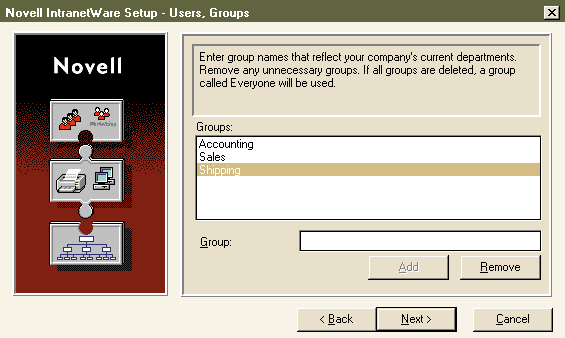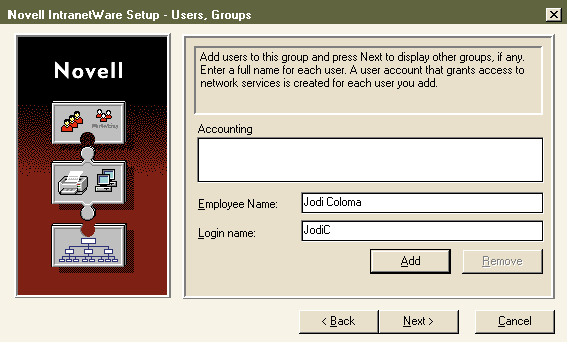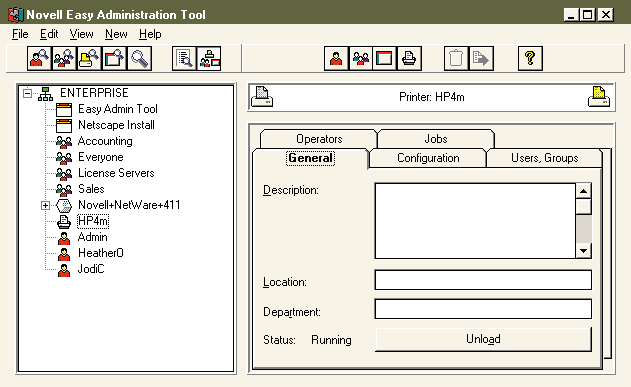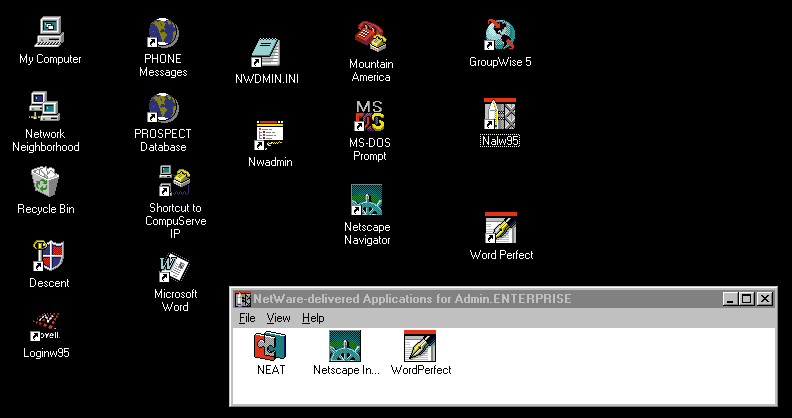NetWare for Small Business 4.11: A Big Solution for Small Networks
Articles and Tips:
01 Aug 1998
In April, Novell released NetWare for Small Business 4.11, an enhanced version of its small business solution. Designed for networks with 25 or fewer users, NetWare for Small Business 4.11 includes simplified management, a streamlined installation process, and worry-free security. NetWare for Small Business 4.11 also includes GroupWise 5.2 and Netscape FastTrack Server for NetWare, as well as integrated network fax, backup, and virus protection products. These enhancements make NetWare for Small Business 4.11 an easy-to-use networking solution for small businesses.
MEETING THE NEEDS OF SMALL BUSINESSES
Although Novell designed NetWare for Small Business 4.11 with small networks in mind, the core of the product is NetWare 4.11. As a result, NetWare for Small Business 4.11 provides the reliability of a fourth generation product with enhancements geared specifically for small networks. In addition, Novell modified some NetWare 4.11 components--such as Novell Directory Services (NDS), installation, management, and security--to make these components easier to use.
Simplified NDS
To many network administrators, a directory service is synonymous with enterprise networks. After all, the purpose of a directory service is to provide users with transparent access to all network resources, regardless of the location of a particular user or resource. A directory service is critical to multisite, multiserver networks, saving time and making the network easier to use and manage. However, a small network with one server, two printers, and 10 users may not need a fully functional directory service.
For this reason, NetWare for Small Business 4.11 includes a scaled-down version of NDS, which Novell calls asingle-site directory. When you install NetWare for Small Business 4.11, the installation program creates one Organization object in the NDS tree and places all of the network resources under this object. You cannot create additional container objects--doing so would add complexity to the NDS tree. And you can create only User, Group, Printer, and Application objects in the NDS tree.
As a result, the NDS tree does not require partitioning. The NDS database is stored as one partition, which is replicated across all servers in the NDS tree. Each server in the NDS tree stores a writeable partition, which allows authorized users to make changes to the NDS database and to authenticate to the NDS tree from any server on the network. Of course, changes made to the NDS database are automatically replicated across each server in the NDS tree.
Simple Installation
Novell has also streamlined the NetWare for Small Business 4.11 installation process. In fact, you can install NetWare for Small Business 4.11 in one hour or less.
To install NetWare for Small Business 4.11, you must first create a DOS partition of at least 100 MB on the server. The bootable installation diskette that is included with NetWare for Small Business 4.11 automatically creates the 100-MB DOS partition, or you can use the DOS FDISK command to create this DOS partition manually.
When you launch the installation program, you are prompted to enter the following information:
Organization name (which becomes the name of your company's NDS tree and the name of the Organization object)
Server name
After you enter this information, the installation program copies files to the DOS partition. The hardware auto-detection feature then selects and loads the appropriate disk, LAN, and CD-ROM drivers for the server.
The only caveat is that the server must have an advanced bus architecture--such as EISA, PCI, PNPISA, PCMCIA, or MCA--or the device type must be SCSI or IDE. If the server or the device does not meet these requirements, the installation program may not select the appropriate driver for the server. In this case, you may need to manually select the driver. After the drivers are loaded successfully, the installation program copies the system files to the server, and the installation process is completed without any other intervention.
Installing the Novell client software is also quick and easy. In most cases, simply inserting the NetWare Clients CD-ROM automatically launches the client installation program, WINSETUP.EXE. (If the autostart feature doesn't work, you can launch this file manually from Windows Explorer or from the Start Menu.)
The client installation program's main menu allows you to choose which client software you want to install: NetWare Client for Windows NT 4.11, NetWare Client for Windows 95 2.2, or NetWare Client for DOS/Windows 2.2. After you have selected the client software you want to install, the client installation program proceeds with the installation process, requiring little or no intervention.
The client installation program automatically places Novell Application Launcher (NAL) 1.01 in the Windows NT or Windows 95 startup folder. You can then use NAL to configure network applications for users and to deliver these applications to users' desktops. Each time a user boots a workstation, icons for these network applications appear on the desktop. (NAL is described in more detail later in this article.)
Automatic Network Configuration
After you have installed NetWare for Small Business 4.11 on the server and the Novell client software on at least one workstation, the initial network configuration is completed. You then need to create User objects and Group objects. Once again, Novell has simplified this process by providing the QuickStart utility to create these NDS objects for you.
The first time you log in to the network as the ADMIN user, the QuickStart utility is launched, and you are prompted to enter your company's departments, which are then listed as groups. As Figure 1 shows, three groups are automatically listed. You can add to or delete these groups as needed. After you have entered the departments, Group objects are created for these departments in NDS.
Figure 1: The QuickStart utility helps you create Group objects for the departments in your company.

The QuickStart utility then prompts you to enter the members of each group. As you enter a member, the QuickStart utility provides a suggested login name. (See Figure 2.) When you click the Add button, a User object is automatically created in NDS and is added as a member of the group.
Figure 2: The QuickStart utility suggests a login name for each User object.

After you have created User and Group objects, you can set up printing services. You are prompted to enter a printer name, the location of the printer (the server or workstation to which the printer is attached), and configuration information (such as parallel or serial port and LPT or COM port number).
With NetWare for Small Business 4.11, Novell has eliminated the headaches of configuring network printing: After you enter the printer information, the Printer, Print Queue, and Print Server objects are created in NDS, and all of the necessary associations are made automatically. And the minute you save the printing information, the print server with the newly configured printer is automatically loaded at the server.
Management Made Easy With NEAT
After you set up printing services, Novell Easy Administration Tool (NEAT) is launched. You can use NEAT to view or to modify the network configuration. (See Figure 3.) NEAT simplifies the process of adding User, Group, Printer, and Application objects to NDS. However, if you are familiar with the NetWare Administrator (NWADMIN) utility or if you prefer a more sophisticated (and complex) utility, you can use the NWADMIN utility. (This utility is located in the SYS:PUBLIC directory on the NetWare for Small Business 4.11 server.)
Figure 3: NEAT allows you to perform network management tasks, such as viewing or modifying a Printer object's properties.

When you use NEAT, you can't help but wonder which came first: the name of the utility or the acronym? This utility is pretty "neat"--especially if you have used Novell's more complex utilities. You can use the NEAT toolbar to view NDS objects by type. For example, you can view only User objects or only Printer objects. You can also use this toolbar to sort NDS objects by name or by type. Sorting NDS objects by type allows you to view objects in a specific order--first listing all Printer objects, followed by all User objects and all Group objects, for example. In addition, you can use this toolbar to add, delete, and rename NDS objects.
When you select an object in the NDS tree, NEAT displays several tabs that allow you to view or to modify that object's properties. For example, if you selected a Printer object, you could configure the printer, authorize User or Group objects to use the printer, or view the printer's job list. (See Figure 3.) These tabs make managing the network quick and easy.
Security Is a Snap
NetWare for Small Business 4.11 also has a simple security scheme: Users are granted either no rights, full rights, or the read-only right to the NetWare file system.
In addition, you do not need to worry about NDS rights. By default, users are granted the necessary NDS rights to view and use the objects in the NDS tree. In fact, NEAT doesn't even provide an option to view NDS rights.
This simplified security scheme meets the needs of most small businesses. However, if you want to implement more granular security, you can use the NWADMIN utility to grant or revoke NDS rights.
ALL FOR ONE AND ONE FOR ALL
To provide a complete solution for small companies, NetWare for Small Business 4.11 includes fully functional versions of the following Novell products:
GroupWise 5.2
Netscape FastTrack Server for NetWare
NetWare MultiProtocol Router (MPR) 4.11
NetWare Connect 2.0
NAL 1.01
Integrated E-mail and Collaboration
By including GroupWise 5.2 with NetWare for Small Business 4.11, Novell gives small businesses the tools they need to communicate effectively across the network or the Internet. Through the GroupWise universal mailbox, users can send and receive e-mail messages and faxes via the network or the Internet. Users can also set up appointments, create tasks, and manage documents and workflows.
Using the integrated calendaring and scheduling capabilities available with GroupWise 5.2, users can keep personal and group calendars and schedule company resources, such as conference rooms. GroupWise 5.2 also provides work-in-progress tracking, shared folders for workgroups, and complete document management services, allowing small businesses to easily manage shared documents. In addition, the Conversation Place feature integrates workstations with your company's PBX system to enable computer-based telephone calls and conference calls.
To make managing the network easier, Novell has tightly integrated GroupWise 5.2 with NetWare for Small Business 4.11. In fact, when you install NetWare for Small Business 4.11, the installation program installs the necessary GroupWise 5.2 components and creates a GroupWise post office. In addition, when you create User objects in NDS, GroupWise universal mailboxes are automatically created for these objects. You no longer need to manage e-mail accounts separately from network accounts.
Integrated Web Server
To provide an easy-to-use World-Wide Web publishing solution, NetWare for Small Business 4.11 includes Netscape FastTrack Server for NetWare. With this web server, small businesses can publish documents with just a click of the mouse. In addition, Netscape FastTrack Server for NetWare provides NetBasic, Perl, and JavaScript, allowing small businesses to build customized web applications.
Netscape FastTrack Server for NetWare is tightly integrated with NetWare for Small Business 4.11. As a result, Netscape FastTrack Server for NetWare leverages the reliability and security of the NetWare operating system, and you can use NDS to manage your company's web server.
Multiprotocol Routing Functions
Another useful feature of NetWare for Small Business 4.11 is the built-in routing functions that NetWare MPR provides. NetWare MPR 4.11 allows companies to support multiple protocols on the network, such as IPX/SPX, TCP/IP, and AppleTalk.
NetWare MPR 4.11 also eliminates the need for an external router: With NetWare MPR, companies can set up WAN connections to the Internet or to Internet service providers (ISPs) using leased lines, Integrated Services Digital Network (ISDN), or frame relay.
Remote Communications
By including NetWare Connect 2.0 with NetWare for Small Business 4.11, Novell addresses the remote communications needs of small businesses. NetWare Connect 2.0 enables users to dial-in from a remote location, connect to the network, and access the network resources to which they have rights.
NetWare Connect 2.0 also provides dial-out capabilities, such as modem and telephone-line sharing. As a result, users can access bulletin boards, online services, or the Internet.
Application Management
As mentioned earlier, NetWare for Small Business 4.11 also includes NAL 1.01, which simplifies the management of network applications. Using NDS, NAL 1.01 delivers network application icons to users' desktops when users log in to the network. You no longer need to walk to each user's workstation to set up network application icons, which saves you considerable time and effort when installing or upgrading network applications.
When you install or upgrade a network application, you use NEAT to create an Application object in the NDS tree. The Application object defines the physical location of the network application and the users who are authorized to use this application. When a user logs in, the network application and any other applications the user is authorized to use are automatically delivered to the user's desktop. (See Figure 4.)
Figure 4: NAL 1.01 delivers network application icons to users' desktops.

You can also use NAL 1.01 to install or upgrade network applications on users' desktops from a central location. In Figure 4, for example, the Netscape In icon allows users to install Netscape Navigator (which is also included with NetWare for Small Business 4.11) on their workstations. When users double-click this icon, the Netscape Navigator installation process is launched.
NOVELL'S SUPPORTING CAST
NetWare for Small Business also includes several third-party products. These products are fully functional, limited-user versions.
FAXserve 5 for NetWare and GroupWise from Computer Associates Inc.
ARCserve 6.1 for NetWare from Computer Associates Inc.
InocuLAN 4.0 for NetWare from Computer Associates Inc.
Oracle8 for NetWare from Oracle Corp.
Netscape Navigator from Netscape Communications Corp.
Network Faxing
To provide a network fax solution, NetWare for Small Business 4.11 includes a two-user version of FAXserve 5. FAXserve 5 is tightly integrated with both NetWare for Small Business 4.11 and GroupWise 5.2. As a result, users can send and receive faxes directly through their GroupWise universal mailbox or from within a Windows application, such as Corel WordPerfect or Microsoft Word. And because all e-mail addresses and fax numbers are stored in the GroupWise address book, users don't have to switch between applications to send a fax.
In addition, FAXserve 5 is integrated with NDS, eliminating the need to maintain a separate database for fax services: You can configure FAXserve 5 users and services at the same time you configure NDS users.
Although a two-user version of FAXserve 5 may seem inadequate for a network with more than two users, there is a possible work-around: You create two User objects specifically for fax services. For example, you could create the FAX1 and FAX2 User objects. Then when users wanted to send faxes, they would simply log in as one of the designated fax users.
The only caveat to this work-around is that incoming faxes cannot be delivered directly to a specific user's GroupWise universal mailbox. The incoming faxes would be delivered to the GroupWise universal mailboxes of the two designated fax users, and someone would have to manually route these faxes to the appropriate users. (For more information about FAXserve, visit the FAXserve home page at http://www.cai.com/products/faxserve.htm.)
Network Backup
NetWare for Small Business 4.11 includes a five-user version of ARCserve 6.1, which backs up and restores both the network file system and NDS. In addition to backing up and restoring NDS objects and their associated attributes, ARCserve 6.1 backs up and restores the NDS schema. (TheNDS schemais a set of rules that define the structure of the NDS database). ARCserve 6.1 is also integrated with NDS, which provides centralized management capabilities.
If you purchase a five-user version of NetWare for Small Business 4.11, the five-user version of ARCserve 6.1 is all you need. However, if you purchase more than five NetWare for Small Business 4.11 licenses, ARCserve 6.1 detects these licenses during the installation process and installs a 30-day, unlimited-user version. If you want to use ARCserve 6.1 after 30 days, you must purchase a full version. (For more information about ARCserve, visit the ARCserve home page at http://www.cheyenne.com/Product-Info/netware/arcserve6-netware-menu.html.)
Virus Protection
To provide virus protection, NetWare for Small Business 4.11 includes a two-user version of InocuLAN 4.0. You can configure InocuLAN 4.0 to perform real-time scanning of network files as they are accessed, or you can schedule a complete scan of the server's hard drive during low-utilization times. You can also integrate InocuLAN 4.0 with ARCserve 6.1 to ensure virus-free backups.
Like the other Computer Associates products, InocuLAN 4.0 is integrated with NDS. As a result, you can select groups of servers and workstations for centralized management, updating, and activity reporting. (For more information about InocuLAN, visit the InocuLAN home page at http://www.cheyenne.com/Product-Info/netware/inoculan-netware-menu.html.)
Database Connectivity
Oracle has long been a leader in the relational--and now object-oriented--database market, and Oracle's products are well-known for their reliability and scalability. Oracle has also had a long-standing relationship with Novell as a database partner. This relationship has continued with the release of Oracle8, which has been fully tested and approved for use with NetWare 5, NetWare 4.11, and NetWare for Small Business 4.11.
Oracle8's advanced features, complemented by the performance of the NetWare operating system and the integration with NDS, provide a winning database combination. Oracle8 provides a single sign-on and a single point of administration for both the Oracle database and the NDS database. If your company has purchased NetWare for Small Business, you can download a five-user version of Oracle8 from Novell's web site (http://www.novell.com/intranetware/oracleorder.html). (You can also download this version if your company has purchased intraNetWare or NetWare 4.11.)
Web Browsing
NetWare for Small Business 4.11 also includes Netscape Navigator, which enables users to browse the web. The number of Netscape Navigator licenses you receive matches the number of NetWare for Small Business 4.11 licenses you purchase. For example, a 25-user version of NetWare for Small Business 4.11 includes a 25-user version of Netscape Navigator.
NODAL LICENSING
In response to customer feedback, Novell has changed the NetWare for Small Business 4.11 licensing scheme to nodal licensing. With nodal licensing, you can purchase the exact number of licenses you need. For example, if your company's network had 10 licensed users and you needed to add another user, you would simply purchase one additional license. Nodal licensing is more economical than a licensing scheme that requires you to purchase licenses in increments of 5, 10, 25, 50, and so on.
When you purchase NetWare for Small Business 4.11, you receive a base license for the server, which includes five user connections. You can then add connection licenses, which you can purchase in increments of one or five.
NetWare for Small Business 4.11 is limited to a maximum of 25 user connections per NDS tree. However, NetWare for Small Business 4.11 actually allows three grace logins, providing a total of 28 connections. The additional connections are for devices, such as print servers, that require a licensed connection to NDS. However, if no devices are using these connections, you can use them for users.
The suggested retail price for the base server license is U.S. $995 and U.S. $65 for each additional connection license. If you are upgrading from intraNetWare for Small Business, the suggested retail price is U.S. $595 for five users, and U.S. $895 for 10 users. Keep in mind that these prices are the suggested retail prices. You can probably purchase NetWare for Small Business 4.11 for 30 to 40 percent less than the suggested retail price.
CONCLUSION
NetWare for Small Business 4.11 is a well-rounded solution for small businesses that need the features and functionality of a complete networking solution at a fraction of the price. NetWare for Small Business is not only feature rich and inexpensive, but it is also extremely easy to use. With the simple installation process and utilities such as the QuickStart utility and NEAT, NetWare for Small Business 4.11 enables small businesses to maintain a network without requiring a networking expert on staff or an outside consultant for support. NetWare for Small Business 4.11 demonstrates Novell's commitment to an important and large segment of the networking market--the small business.
For more information about NetWare for Small Business 4.11, visit Novell's web site (http://www.novell.com/smallbiz). You can also call 1-800-NETWARE or 1-801-861-5588.
Sandy Stevens is a freelance writer based in Salt Lake City, Utah. She is the coauthor ofNovell's Guide to NetWare Printing, Novell's Guide to BorderManager,andNovell's Guide to Integrating IntranetWare and NT--all of which are available from Novell Press.
NetWare Connection,August 1998, pp. 22-28
* Originally published in Novell Connection Magazine
Disclaimer
The origin of this information may be internal or external to Novell. While Novell makes all reasonable efforts to verify this information, Novell does not make explicit or implied claims to its validity.